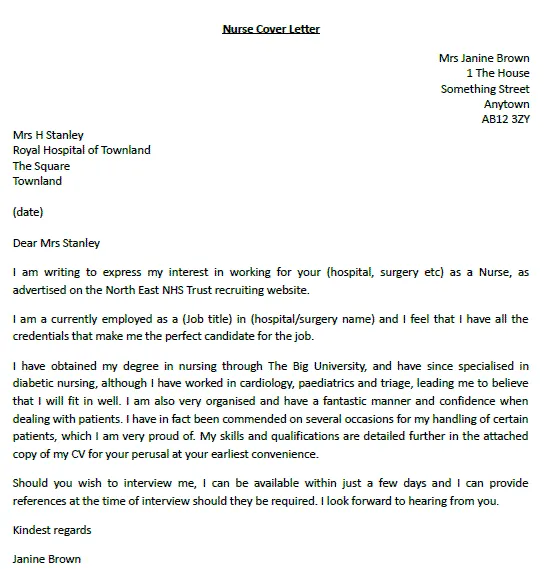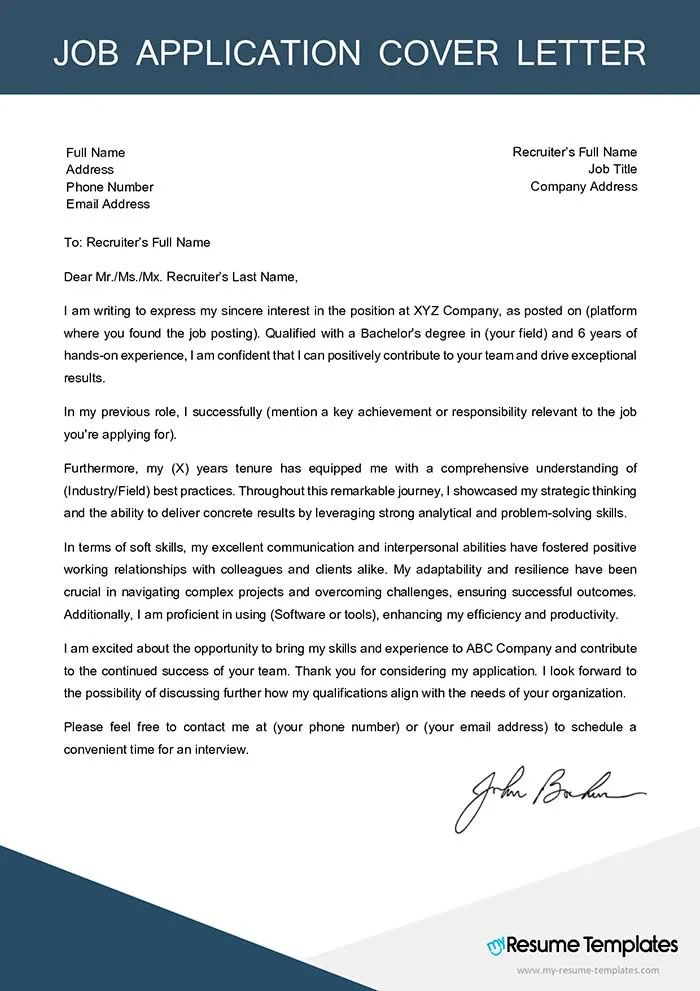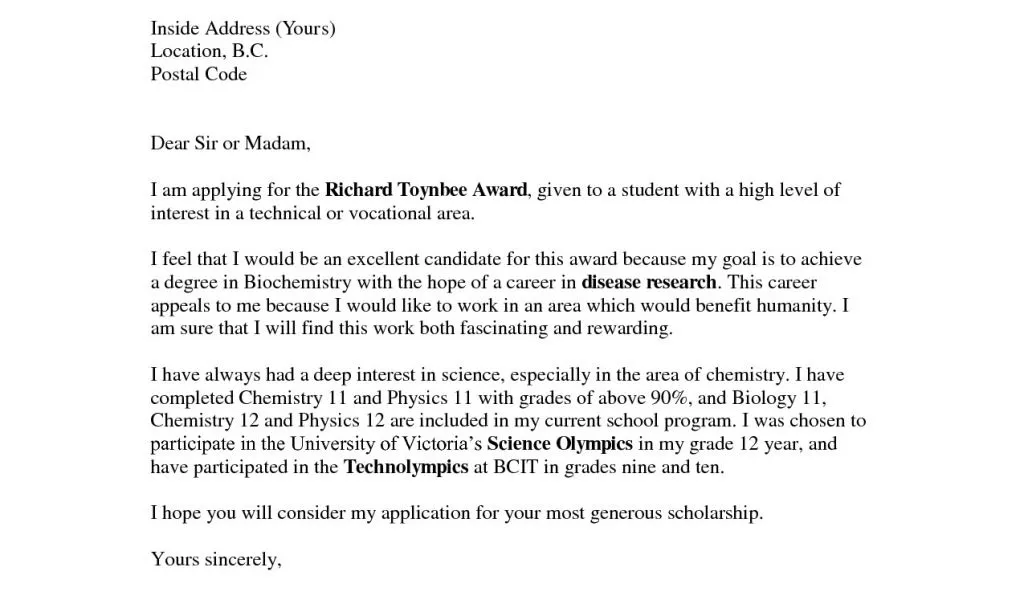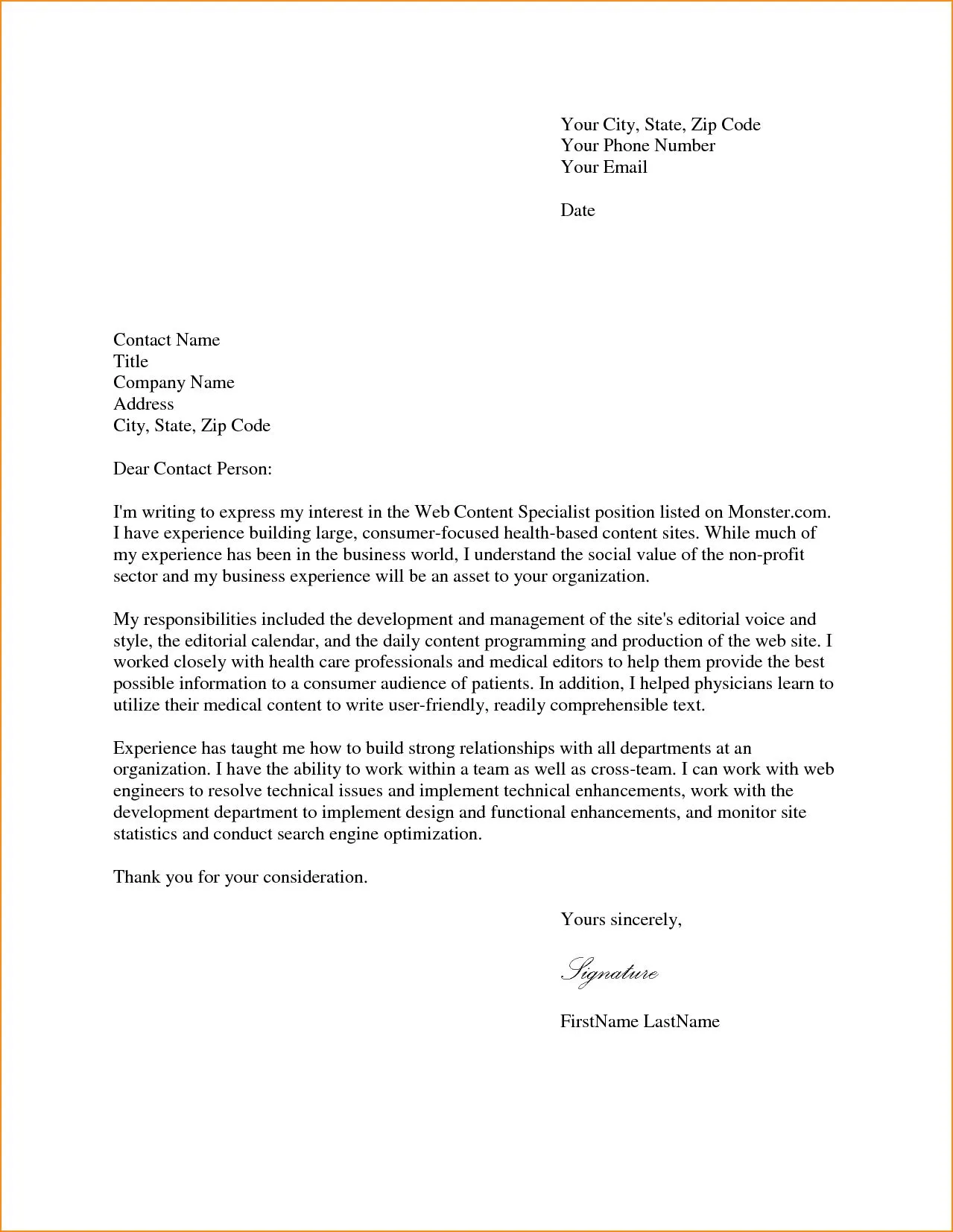Understanding the Importance of a Cover Letter
In the competitive landscape of job applications, a well-crafted cover letter is your opportunity to make a strong first impression and distinguish yourself from other candidates. It serves as more than just a formality; it’s a crucial tool that allows you to showcase your personality, highlight your relevant skills and experience, and express your genuine interest in the position and the company. While your resume provides a snapshot of your qualifications, the cover letter enables you to tell your story, explain your career goals, and demonstrate why you’re the ideal fit for the role. A cover letter is not merely a summary of your resume, but an expansion and personalization of your professional narrative. It allows you to address the specific needs of the job and demonstrate how your qualifications align with the employer’s requirements. A compelling cover letter can significantly increase your chances of securing an interview, making it a vital component of any successful job application strategy. It is your chance to speak directly to the hiring manager, offering insights into your motivations and aspirations that a resume alone cannot convey.
Why a Cover Letter is Essential
A cover letter provides a platform to elaborate on your qualifications and tailor your application to the specific job. It enables you to explain any gaps in your employment history, highlight your accomplishments, and express your enthusiasm for the company. Moreover, it’s a chance to showcase your written communication skills, attention to detail, and understanding of the role and the industry. Many hiring managers value a cover letter as it shows your proactive approach and genuine interest, setting you apart from candidates who may only submit a resume. The cover letter provides context to your resume, helping the recruiter understand why you are the best fit for the role. It is where you can demonstrate your alignment with the company’s values and culture. This personalized approach goes a long way in making a memorable and positive impression, which is paramount in landing the job. It gives you the space to articulate why you are the best candidate for the role and demonstrate your unique value proposition.
When a Cover Letter is Not Needed

Although cover letters are often expected, there are situations when they might not be necessary or requested. Some online application portals may explicitly state that a cover letter is optional, or in certain industries, a cover letter might be less common. Always carefully review the job posting and application instructions to determine whether a cover letter is required. If it’s optional, it’s often still a good idea to include one, especially if you want to stand out. It is advisable to submit a cover letter unless the application specifically states that it is not required. For some roles, such as government jobs, the application process might have specific instructions or required forms, which may replace the need for a cover letter. Always adhere to the guidelines and instructions provided by the employer to maximize your chances of success.
Key Components of a Winning Cover Letter
Your Contact Information and Date
Start your cover letter with your contact information at the top. Include your full name, address, phone number, and professional email address. Ensure that your contact information is accurate and up-to-date. Below your contact information, include the date. This is a simple but important step that gives your cover letter a formal structure and helps the hiring manager to easily identify when you submitted your application. Make sure the date format is consistent and clear. The contact information should be properly formatted, and easily readable at a glance. It should be placed on the top left or right corner of the cover letter. The date is important to show that you’re current in your job search and it is typically placed below your contact information.
The Hiring Manager’s Information

Address your cover letter to a specific person, if possible. Research the hiring manager’s name and title. This personal touch shows that you have taken the time to learn about the company and the role. If you can’t find a specific name, use a professional salutation, such as “Dear Hiring Manager” or “Dear [Department Name] Team.” Avoid generic greetings. Addressing the letter to a specific person adds a personal touch, showing that you have taken the time to find out who will be reading your application. This also demonstrates your attention to detail and interest in the position. If you are unable to locate a hiring manager’s name, it is acceptable to use a general salutation, but personalized approaches are always preferable.
Crafting a Compelling Opening
Your opening paragraph is crucial for grabbing the reader’s attention. Start with a strong statement that highlights why you’re interested in the position and the company. You can mention a specific accomplishment, a skill that aligns with the job requirements, or your understanding of the company’s mission. Avoid generic openings like, “I am writing to express my interest…” Instead, make your opening unique and tailored to the specific job. This is your first chance to impress the hiring manager, so make it count. Make it clear why you are applying for this particular role and company. Demonstrate your understanding of their needs and how you can fulfill them. Ensure your opening is concise, impactful, and directly addresses the job requirements.
Highlighting Your Relevant Skills and Experience
In the body of your cover letter, explain how your skills and experience align with the job requirements. Use specific examples to illustrate your accomplishments and quantify your achievements whenever possible. Focus on the most relevant aspects of your background and tailor your examples to the job description. Instead of just listing your skills, show how you’ve used them to achieve results. Use the STAR method (Situation, Task, Action, Result) to structure your examples and provide context. It will show how you approach and solve issues within the workplace. This will make your qualifications more compelling and memorable. Quantify your achievements. Use numbers and data to demonstrate your impact in previous roles, such as increasing sales, reducing costs, or improving efficiency.
Tailoring Your Cover Letter to the Job Description

Carefully review the job description and identify the key requirements and keywords. Customize your cover letter to address these specific requirements. Highlight the skills, experiences, and qualifications that match the job description. Avoid using a generic cover letter; customize each one for the specific role. This shows that you have thoroughly researched the position and understand what the employer is looking for. Make sure your letter reflects an understanding of the company culture and values, and how your skills can contribute to their success. Always use the same language and terminology as the job description. By using the same keywords and phrases, you increase your chances of passing applicant tracking systems and catching the hiring manager’s attention.
Quantifying Your Achievements
Whenever possible, quantify your achievements with numbers and data. Instead of saying “Improved customer satisfaction,” say “Increased customer satisfaction by 15%.” Provide concrete evidence of your impact in previous roles. Quantifying your accomplishments makes your cover letter more compelling and shows the value you bring to a company. Use metrics to showcase your successes, and highlight the results you achieved. Quantifiable achievements help demonstrate your competence and the value you can bring to the new role. Examples of this could include increasing sales by a certain percentage, reducing costs, or improving efficiency within the workplace. Make sure that all figures and data are accurate.
Demonstrating Your Enthusiasm for the Company
Show your genuine interest in the company by mentioning something specific about their mission, values, or recent accomplishments. Research the company’s culture and values and explain why they resonate with you. This demonstrates that you have done your homework and that you are genuinely interested in working for the organization. Mentioning the company’s recent achievements shows that you are paying attention to their activities. Demonstrate how your values align with those of the company. Doing so will make you stand out from other candidates. This will show that you are more than just a candidate and are also a cultural fit. Show your excitement for the opportunity and express a desire to contribute to the company’s success.
Writing a Strong Closing

End your cover letter with a strong call to action. Reiterate your interest in the position, and express your eagerness to discuss your qualifications further in an interview. Thank the hiring manager for their time and consideration. Provide your contact information again, making it easy for them to reach you. Keep your closing concise, and professional. Do not use overly formal language; a straightforward and confident closing is generally best. Always close with a professional sign-off, such as “Sincerely,” “Best regards,” or “Thank you for your time.” Ensure your closing reflects your enthusiasm for the role and reinforces your key qualifications. Finally, make sure to proofread your closing for any spelling or grammatical errors.
Proofreading and Formatting Your Cover Letter
Formatting for Readability
Use a professional and clean format that is easy to read. Choose a simple font, such as Times New Roman, Arial, or Calibri, and keep the font size between 11 and 12 points. Use clear headings, bullet points, and spacing to break up the text and make it easier to scan. Keep paragraphs concise, and use a professional layout. Avoid excessive use of bold, italics, or underlining. Make sure that the margins are consistent and the text is aligned. Proper formatting makes your cover letter look polished and professional. Ensure that the layout is consistent throughout the document. A well-formatted cover letter demonstrates attention to detail and professionalism, making a good impression on the hiring manager.
Common Mistakes to Avoid

Overusing ‘I’ Statements
While it’s important to highlight your accomplishments, avoid overusing the word “I.” Balance your statements with action verbs and focus on your achievements rather than simply stating what you did. Try to keep the focus on your actions and accomplishments. To prevent overusing “I,” try rephrasing sentences to emphasize what you achieved or how your skills benefit the company. Focus on the impact of your contributions. This will make your cover letter sound more concise, confident, and impactful. By using action verbs, you make your writing more dynamic and engaging, helping the hiring manager quickly grasp your key contributions.
Generic Cover Letters
Avoid using a generic cover letter that you send to every job application. Customize each cover letter to match the specific job requirements and the company’s culture. Generic letters show a lack of interest and attention to detail. Spend the time to tailor your cover letter to each job. This demonstrates your genuine interest in the position and company. Personalized cover letters make a stronger impression, improving your chances of getting an interview. Research the company and customize your letter to showcase your understanding of their needs and how your skills align with the role’s responsibilities. Make sure that your letter reflects an understanding of the company culture and values, and how your skills can contribute to their success.
Typos and Grammatical Errors

Typos and grammatical errors can be a major turnoff for hiring managers. Always proofread your cover letter carefully before submitting it. Use spell-check and grammar-check tools, but don’t rely on them completely. Read the letter aloud to catch any errors that you might have missed. Have someone else proofread your cover letter to catch any mistakes that you might have missed. A well-written and error-free cover letter shows that you pay attention to detail and have a commitment to quality. Poorly written cover letters create a negative impression of your professionalism and attention to detail. Always review your cover letter multiple times. A clean cover letter is vital for making a positive first impression.
Examples of Effective Cover Letters
Cover Letter Example for a Marketing Position
Dear [Hiring Manager Name],
I am writing to express my keen interest in the Marketing Specialist position at [Company Name], as advertised on [Platform]. With five years of experience in digital marketing and a proven track record of driving brand awareness and increasing sales, I am confident that I possess the skills and passion to excel in this role.
In my previous role at [Previous Company], I spearheaded a social media campaign that increased engagement by 40% and generated a 20% increase in website traffic. I am adept at developing and executing marketing strategies, managing budgets, and analyzing campaign performance. My proficiency in SEO, content marketing, and data analytics, combined with my creativity and strong communication skills, aligns perfectly with the requirements of this position. I am also very familiar with Google Ads, and have used the platform in previous positions.
I am particularly drawn to [Company Name]’s innovative approach to [Industry] and its commitment to [Company Value]. I am eager to contribute my skills and experience to help [Company Name] achieve its marketing objectives. I have attached my resume for your review and welcome the opportunity to discuss my qualifications further in an interview.
Thank you for your time and consideration.
Sincerely, [Your Name]
Cover Letter Example for an Entry-Level Role
Dear [Hiring Manager Name],
I am writing to express my interest in the entry-level [Position Name] position at [Company Name], as advertised on [Platform]. As a recent graduate of [University Name] with a degree in [Your Degree], I am eager to launch my career in [Industry] and contribute my skills to a dynamic and innovative team.
During my academic studies, I developed a strong foundation in [Relevant Skills]. I gained hands-on experience in [Relevant Experience] through internships and projects, where I honed my abilities in [Specific Skills]. I am a quick learner, a team player, and possess excellent communication and problem-solving skills. I am particularly excited about the opportunity to learn and grow within [Company Name]’s supportive environment. My project management experience and attention to detail have enabled me to achieve great results.
I am impressed by [Company Name]’s commitment to [Company Value] and its innovative approach to [Industry]. I am enthusiastic about the opportunity to contribute to your team and learn from experienced professionals. I have attached my resume for your review and welcome the opportunity to discuss how my skills and enthusiasm can benefit [Company Name].
Thank you for your time and consideration.
Sincerely, [Your Name]
